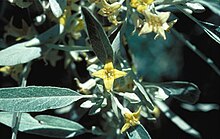Elaeagnus angustifolia
| Elaeagnus angustifolia | |
|---|---|
 |
|
| Scientific classification | |
| Kingdom: | Plantae |
| (unranked): | Angiosperms |
| (unranked): | Eudicots |
| (unranked): | Rosids |
| Order: | Rosales |
| Family: | Elaeagnaceae |
| Genus: | Elaeagnus |
| Species: | E. angustifolia |
| Binomial name | |
|
Elaeagnus angustifolia L. |
|
Elaeagnus angustifolia, commonly called Russian olive,silver berry,oleaster,Persian olive, or wild olive, or commonly referred to as senjid or sinjid in Afghanistan and senjed in Iran, is a species of Elaeagnus, native to western and central Asia, Afghanistan, from southern Russia and Kazakhstan to Turkey and Iran. It is now also widely established in North America as an introduced species.
Its common name comes from its similarity in appearance to the olive (Olea europaea), in a different botanical family, Oleaceae.
Elaeagnus angustifolia is a usually thorny shrub or small tree growing to 5–7 metres (16–23 ft) in height. Its stems, buds, and leaves have a dense covering of silvery to rusty scales. The leaves are alternate, lanceolate, 4–9 cm (1 1⁄2–3 1⁄2 in) long and 1–2.5 cm (3⁄8–1 in) broad, with a smooth margin. The highly aromatic flowers, produced in clusters of one to three, and are 1 cm long with a four-lobed creamy yellow calyx; they appear in early summer and are followed by clusters of fruit, a small cherry-like drupe 1.0–1.7 cm (13⁄32–21⁄32 in) long, orange-red covered in silvery scales. The fruits are edible and sweet, though with a dryish, mealy texture.
The shrub can fix nitrogen in its roots, enabling it to grow on bare mineral substrates.
Elaeagnus angustifolia was described as Zizyphus cappadocica by John Gerard, and was grown by John Parkinson by 1633, and was also grown in Germany in 1736. It is now widely grown across southern and central Europe as a drought-resistant ornamental plant for its scented flowers, edible fruit, attractive yellow foliage, and black bark.
...
Wikipedia
